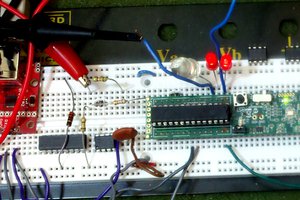This robot has a lot of potential for feature creeping, especially because I have an end goal of integrating the idea with computer vision and spherical rotations. I want it not only turn to the source, but recognize and pinpoint the source.
But to start, the robot will just turn in a 2d plane to face the direction of a sound source. All I've done to start is come up with the equation
where theta is the desired angle, delta t is the measured time difference that it takes for the sound to get from one ear to the other, and T is length measured between the ears divided by the speed of sound. The sign of delta t will determine which ear heard the sound first.
 JangoJungle
JangoJungle


 kelvinA
kelvinA
 Bruce Land
Bruce Land